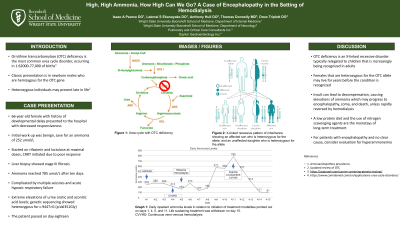Back


Poster Session D - Tuesday Morning
Category: Liver
D0534 - High, High Ammonia, How High Can We Go? A Case of Encephalopathy in the Setting of Hemodialysis
Tuesday, October 25, 2022
10:00 AM – 12:00 PM ET
Location: Crown Ballroom

Has Audio

Lakmal S. Ekanayake, DO
Wright State University Boonshoft School of Medicine
Centerville, OH
Presenting Author(s)
Isaac Pearce, DO1, Lakmal S. Ekanayake, DO2, Gage Hull, DO1, Thomas Donnelly, MD3, Drew Triplett, DO4
1Wright State University Boonshoft School of Medicine, Dayton, OH; 2Wright State University Boonshoft School of Medicine, Centerville, OH; 3Pulmonary & Critical Care Consultants Inc., Dayton, OH; 4Wright State University, Dayton, OH
Introduction: The incidence of Urea Cycle Disorders (UCDs) is extremely rare with very few cases being reported. estimated to be less than 0.00001% of live births. Ornithine transcarbamylase (OTC) deficiency is the most common of the UCD, with an incidence estimated to be 1 in every 60,000 births. Classical presentation is at birth with a newborn male, resulting in coma and demise. Here, we describe a mysterious case of rising ammonia levels in a 66-year-old female.
Case Description/Methods: A 66-year-old woman with a past medical history of developmental delay and recent ischemic stroke presented to the hospital from her extended care facility for decreased responsiveness. Initial work-up revealed an ammonia of 252 umol/L, for which rifaximin 550mg twice daily and lactulose 30mg four times daily were initiated. Hospitalization was complicated by acute hypoxic respiratory failure, resulting in intubation. Despite rifaximin and lactulose, the ammonia level increased to 280umol/L and continuous renal replacement therapy (CRRT) was initiated with twice daily lactulose enemas. Despite these interventions, ammonia continued to rise, peaking at 785umol/L on the tenth day of admission despite CRRT. During hospitalization, the patient experienced multiple seizures. Electroencephalogram (EEG) revealed seizures emanating from the left anterior mid temporal head region. Liver workup consisted of right upper quadrant (RUQ) ultrasound, biopsy, drug toxin level and hepatitis workup. Biopsy demonstrated stage III fibrosis. Negative hepatitis panel and normal salicylates and acetaminophen levels. UCD workup included urine amino acids analysis and genetic sequencing. Urine showed severely elevated orotic and aconitic acid levels. Furthermore, genetic sequencing revealed heterozygous gene for c.944T >G (p.Val351Gly), leading to the diagnosis of Ornithine transcarbamylase (OTC) deficiency. Unfortunately, the patient passed eighteen days after admission.
Discussion: OTC is a X-linked recessive disorder with a survival rate to the age of 12 is approximately 20%. Accumulating ammonia levels, results in encephalopathy, coma and eventual death. Treatment consists of low protein diet, and the use of nitrogen scavenging agents. The use of lactulose and rifaximin are popular and effective. Clinicians should be aware of atypical presentations of hyperammonemia in the setting of ultrafiltration given the late onset and poor outcomes.
Disclosures:
Isaac Pearce, DO1, Lakmal S. Ekanayake, DO2, Gage Hull, DO1, Thomas Donnelly, MD3, Drew Triplett, DO4. D0534 - High, High Ammonia, How High Can We Go? A Case of Encephalopathy in the Setting of Hemodialysis, ACG 2022 Annual Scientific Meeting Abstracts. Charlotte, NC: American College of Gastroenterology.
1Wright State University Boonshoft School of Medicine, Dayton, OH; 2Wright State University Boonshoft School of Medicine, Centerville, OH; 3Pulmonary & Critical Care Consultants Inc., Dayton, OH; 4Wright State University, Dayton, OH
Introduction: The incidence of Urea Cycle Disorders (UCDs) is extremely rare with very few cases being reported. estimated to be less than 0.00001% of live births. Ornithine transcarbamylase (OTC) deficiency is the most common of the UCD, with an incidence estimated to be 1 in every 60,000 births. Classical presentation is at birth with a newborn male, resulting in coma and demise. Here, we describe a mysterious case of rising ammonia levels in a 66-year-old female.
Case Description/Methods: A 66-year-old woman with a past medical history of developmental delay and recent ischemic stroke presented to the hospital from her extended care facility for decreased responsiveness. Initial work-up revealed an ammonia of 252 umol/L, for which rifaximin 550mg twice daily and lactulose 30mg four times daily were initiated. Hospitalization was complicated by acute hypoxic respiratory failure, resulting in intubation. Despite rifaximin and lactulose, the ammonia level increased to 280umol/L and continuous renal replacement therapy (CRRT) was initiated with twice daily lactulose enemas. Despite these interventions, ammonia continued to rise, peaking at 785umol/L on the tenth day of admission despite CRRT. During hospitalization, the patient experienced multiple seizures. Electroencephalogram (EEG) revealed seizures emanating from the left anterior mid temporal head region. Liver workup consisted of right upper quadrant (RUQ) ultrasound, biopsy, drug toxin level and hepatitis workup. Biopsy demonstrated stage III fibrosis. Negative hepatitis panel and normal salicylates and acetaminophen levels. UCD workup included urine amino acids analysis and genetic sequencing. Urine showed severely elevated orotic and aconitic acid levels. Furthermore, genetic sequencing revealed heterozygous gene for c.944T >G (p.Val351Gly), leading to the diagnosis of Ornithine transcarbamylase (OTC) deficiency. Unfortunately, the patient passed eighteen days after admission.
Discussion: OTC is a X-linked recessive disorder with a survival rate to the age of 12 is approximately 20%. Accumulating ammonia levels, results in encephalopathy, coma and eventual death. Treatment consists of low protein diet, and the use of nitrogen scavenging agents. The use of lactulose and rifaximin are popular and effective. Clinicians should be aware of atypical presentations of hyperammonemia in the setting of ultrafiltration given the late onset and poor outcomes.
Disclosures:
Isaac Pearce indicated no relevant financial relationships.
Lakmal Ekanayake indicated no relevant financial relationships.
Gage Hull indicated no relevant financial relationships.
Thomas Donnelly indicated no relevant financial relationships.
Drew Triplett indicated no relevant financial relationships.
Isaac Pearce, DO1, Lakmal S. Ekanayake, DO2, Gage Hull, DO1, Thomas Donnelly, MD3, Drew Triplett, DO4. D0534 - High, High Ammonia, How High Can We Go? A Case of Encephalopathy in the Setting of Hemodialysis, ACG 2022 Annual Scientific Meeting Abstracts. Charlotte, NC: American College of Gastroenterology.
